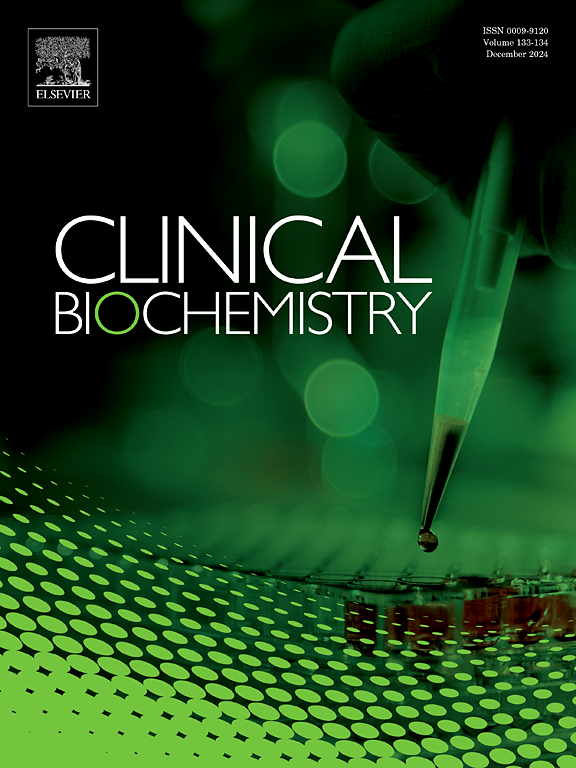Phenotyping and genotyping for the dihydropyrimidine dehydrogenase test in Italy: a precise diagnostic strategy to detect rare variants and improve drug administration
IF 2.1
3区 医学
Q2 MEDICAL LABORATORY TECHNOLOGY
引用次数: 0
Abstract
Introduction
Dihydropyrimidine dehydrogenase (DPD) is the enzyme implicated in the catabolism of the fluoropyrimidines (FP), a class of chemotherapeutics used to treat many cancers. The DPYD gene is known to have a huge number of variants potentially associated with DPD deficiency. Therefore, phenotypic and genotypic characterization of DPD is fundamental for cancer patients before undergoing treatment with FP. The AIOM (Italian Association of Medical Oncology) requires genetic analysis, with the purpose to identify a panel of 5 single nucleotide polymorphisms associated with 5-fluorouracil (5-FU)-induced toxicity, while the biochemical test, which measures uracil levels to predict the residual activity of DPD, is only recommended and not mandatory.
Methods
Single nucleotide polymorphisms were analyzed by real-time polymerase chain reaction (PCR) from peripheral blood. Uracil and dihydrouracil were quantified using an ultra-performance liquid chromatography/tandem mass spectrometry system in plasma obtained from patients before 5-FU treatment. Sanger sequencing was performed for the DPYD gene.
Results
Here, we describe the case of a 70-year-old Caucasian male patient with pancreatic cancer for whom real-time PCR highlighted a heterozygous pathogenic variant c.1905 + 1G > A associated with a 50 % reduction of DPD enzymatic activity. This finding was not confirmed by the biochemical test which revealed a complete absence of DPD activity. By performing Sanger sequencing, we highlighted the concomitant presence of a likely pathogenic variant c.2622 + 1G > A, not compatible with the administration of 5-FU.
Conclusion
Thus far, guidelines provide a limited panel for the identification of pathogenic or likely pathogenic variants of the DPYD gene, therefore we encourage the mandatory use of biochemical tests as a precise diagnostic strategy to detect rare variants and improve drug administration.
意大利二氢嘧啶脱氢酶检测的表型和基因分型:一种检测罕见变异和改进药物管理的精确诊断策略。
简介:二氢嘧啶脱氢酶(DPD)是与氟嘧啶(FP)的分解代谢有关的酶,氟嘧啶(FP)是一类用于治疗许多癌症的化疗药物。众所周知,DPYD基因有大量可能与DPD缺乏症相关的变异。因此,在接受FP治疗之前,DPD的表型和基因型特征是癌症患者的基础。AIOM(意大利肿瘤医学协会)要求进行遗传分析,目的是确定与5-氟尿嘧啶(5- fu)引起的毒性相关的5个单核苷酸多态性,而生化试验(通过测量尿嘧啶水平来预测DPD的残留活性)只是推荐的,而不是强制性的。方法:采用实时聚合酶链反应(real-time polymerase chain reaction, PCR)检测外周血单核苷酸多态性。采用超高效液相色谱/串联质谱系统对5-FU治疗前患者血浆中的尿嘧啶和二氢尿嘧啶进行定量分析。对DPYD基因进行Sanger测序。结果:在这里,我们描述了一个70岁的高加索男性胰腺癌患者的病例,实时PCR显示了一个杂合致病变异c.1905 + 1G > a与50% %的DPD酶活性降低相关。这一发现没有得到生化测试的证实,生化测试显示完全没有DPD活性。通过进行Sanger测序,我们强调了可能伴随的致病变异c.2622 + 1G > a的存在,与5-FU的管理不兼容。结论:到目前为止,指南提供了一个有限的小组来鉴定致病性或可能致病性的DPYD基因变异,因此我们鼓励强制使用生化试验作为一种精确的诊断策略,以发现罕见的变异和改善药物给药。
本文章由计算机程序翻译,如有差异,请以英文原文为准。
求助全文
约1分钟内获得全文
求助全文
来源期刊

Clinical biochemistry
医学-医学实验技术
CiteScore
5.10
自引率
0.00%
发文量
151
审稿时长
25 days
期刊介绍:
Clinical Biochemistry publishes articles relating to clinical chemistry, molecular biology and genetics, therapeutic drug monitoring and toxicology, laboratory immunology and laboratory medicine in general, with the focus on analytical and clinical investigation of laboratory tests in humans used for diagnosis, prognosis, treatment and therapy, and monitoring of disease.
 求助内容:
求助内容: 应助结果提醒方式:
应助结果提醒方式:


